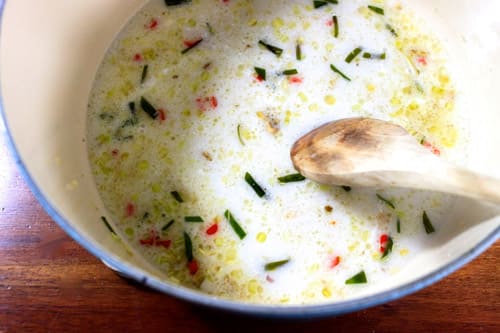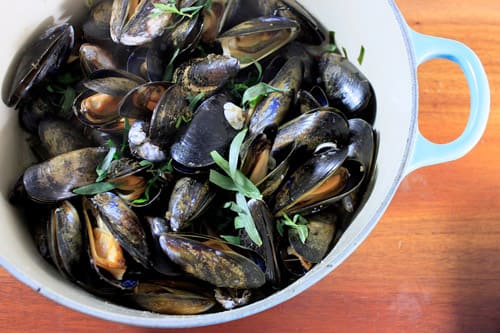Our site uses cookies to give you the best experience. or continue shopping if you're happy.
Accept & closeHow to cook mussels (5 different ways!)
So simple and versatile, you'll wonder why it was ever a mystery!
"I never order mussels in a restaurant, for the precisely opposite reason that so many do: I can cook them so easily at home that I don’t really see the point in paying a huge mark-up for someone else to do it for me. Despite their extremely low cost and high ease of preparation and cooking, mussels still seem to carry a bit of an aura of mystique about them, the precise minutiae of their cooking requirements largely unknown to many people for whom they seem exotic, a treat, the kind of dish only consumed in a restaurant setting."
I’m out to change this, and to show you not only how easy it is to cook mussels, but how versatile they can be once you’ve mastered the basic technique. There’s really no excuse not to – shellfish allergies aside – because mussels are cheap (a kilo will set you back under £4, and will feed four as a starter or two as a main course), sustainable (how many fish can you say that about these days?), plentiful, in season for most of the year (except when there isn’t an ‘R’ in the month, so from May to August) and delicious. There’s no other food quite so satisfying, I don’t think: something about the way they have to appear piled high in a bowl and involve the extraction of those succulent nuggets of sweet flesh from inside their shells is just plain good gastronomic fun, especially if you have a bottle of wine and some friends to share with. In my second year at university I cooked a feast of mussels for several friends, but there was no space at the table in my shared kitchen, so we ate off the floor in my room downstairs. The cleaner was a bit bemused the next morning when she emptied my bedroom bin and found it full of mussel shells.
Here’s your foolproof guide to cooking these tasty morsels
Buy
Most fishmongers and supermarket fish counters will have them, often sold in net bags that weigh approximately a kilo. You will need around 500g per person for a main course, or 250g for a starter (assuming you’re serving something alongside, like bread to mop up the delicious cooking liquid). You can often ask supermarkets to cut open a bag if you don’t need a whole kilo. Buy your mussels no more than a day before you intend to cook them; any longer and you risk them dying.
Store
Keep them in a bowl or plastic bag in the fridge with some scrunched up newspaper or kitchen towel soaked in water over the top of them. Don’t keep them tied up in a plastic bag; they are living things and need to breathe, so open it up.
Prepare
To prepare them for cooking, you need to clean and ‘de-beard’ them. Do this right before you plan to cook them (about 15 minutes before is fine), not in advance as it will kill them. Rinse the mussels well under running water, then pull off the grey tangled ‘beard’ you will find sticking out of the shell on one side. Give it a sharp tug and it will come off. Discard any mussels that are cracked or broken, or that are open and don’t close when tapped sharply against a worktop. Put the mussels in a colander or bowl until ready to cook.
Flavour base
This is usually a series of aromatics that you fry in a little oil before adding liquid, to give flavour to the mussels. Do this in a large, lidded saucepan big enough to accommodate all the mussels. Here are some suggestions:
- For French-style moules mariniere, use crushed garlic, a finely chopped shallot, a couple of bay leaves, and a few sprigs of thyme. I also sometimes add peeled finely diced fresh tomatoes to this.
- For Thai-style, use garlic, lemongrass, chilli, shredded kaffir lime leaves (you can buy these frozen in Asian grocers) and ginger
- For a meaty classic, use a finely chopped shallot, some fat bacon lardons, and some crushed garlic
- For another meaty version, this time Spanish-themed, use chunks of cooking chorizo instead of the bacon, and add halved cherry tomatoes or diced whole tomatoes
Liquid
You then need to add liquid, after sautéing your flavour base in oil for a couple of minutes. This will depend on your aromatics.
- For French-style, use white wine and maybe a little cream if you’re feeling decadent
- For Thai-style, use coconut milk
- For the bacon version, use cider or beer
- For the chorizo version, use cider or white wine
Simmer
Simmer the liquid for a minute or so, then taste the sauce and season. Don’t add too much salt, though, because the beauty of mussels is they release a delicious salty cooking liquor when they open that will add to the sauce in the pan and season it beautifully.
Add the mussels
Turn the heat up high then tip them in and put on a lid. Cook for approximately 4 minutes, shaking the pan regularly, until all the mussels have opened. As soon as they have, turn off the heat – if you overcook them they’ll be rubbery and horrible. Discard any that haven’t opened fully (TRUST ME, this may lead to food poisoning if you don’t, I speak from bitter and recent experience), then ladle your mussels into bowls along with their accompanying liquid to serve.
Garnish
You can then garnish them with some finely chopped herbs.
- For French-style, use flat leaf parsley
- For Thai-style, use coriander, tarragon or Thai basil
- For the bacon version, use parsley or thyme
- For the chorizo version, use coriander, parsley or basil
Lemon or lime
Serve with lemon or lime (for the Thai version) wedges to squeeze over.
Bread
You can also serve with bread. I would always go for a chunk of crusty bread, except for the Thai version which I like to serve over a bed of rice or rice noodles.
So there you have it: a basic blueprint for cooking mussels. As long as you keep the method the same, you can have fun playing around with the flavours and the aromatics: a base of sautéed ingredients, a little liquid, a herb garnish, and citrus for squeezing. The below recipe is for Thai-style mussels, but keep the quantities the same and you can adapt it for lots of other flavours.
There’s really no excuse to save mussels for a restaurant occasion now.
Asian-style mussels in coconut broth (serves 2 as a main course)
Here's what you'll need
- 1kg mussels
- 1 tbsp rapeseed oil
- 1 clove garlic, crushed
- 2 lemongrass stalks, finely chopped
- A 1 inch piece fresh ginger, grated
- 1 red Thai chilli, finely chopped
- 2 kaffir lime leaves, shredded
- 200ml coconut milk
- A small bunch of fresh tarragon or Thai basil
- Lime wedges, to serve
Here's how it's done
Step 1
First, prepare the mussels (do this just before you start to cook). Rinse them under cold water then remove the ‘beards’. Put in a colander until ready to cook.

Step 2
In a large saucepan with a lid, heat the oil over a medium heat. Add the garlic, lemongrass, ginger, chilli and lime leaves, then sauté for a few minutes until fragrant and softened. Add the coconut milk then simmer for a minute or so. Taste; you may want to add a little brown sugar or Thai fish sauce to get the right balance of salty/sweet/sour.

Step 3
Turn the heat up high and add the mussels to the pan. Put on the lid and cook for around 4 minutes, shaking the pan occasionally, until all the mussels have opened fully. Discard any that haven’t, then ladle the mussels and broth into large bowls (preferably over rice or rice noodles). Scatter over the tarragon and serve with lime wedges to squeeze over.


